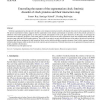Free Online Productivity Tools
i2Speak
i2Symbol
i2OCR
iTex2Img
iWeb2Print
iWeb2Shot
i2Type
iPdf2Split
iPdf2Merge
i2Bopomofo
i2Arabic
i2Style
i2Image
i2PDF
iLatex2Rtf
Sci2ools
CANDC
2006
ACM
2006
ACM
Unraveling the nature of the segmentation clock: Intrinsic disorder of clock proteins and their interaction map
Vertebrate segmentation has been proved to be under a strict temporal control governed by a biological clock, known as the segmentation clock. The present experimental evidence suggests that the segmentation clock initiates and maintains its periodic cycle by the periodic activation or inhibition of the Notch signaling pathway as well as the periodic autoregulation of the cyclic genes themselves. In this paper, we investigate the structural and evolutionary properties of the Notch pathway proteins involved in the mice segmentation clock and computationally identify the interaction map within the Notch signaling pathway. The results of our analysis strongly indicate that most of the pathway proteins are intrinsically disordered and that the mechanism of their interaction likely involves helical molecular recognition elements, short loosely structured segments within disordered regions which are directly involved in protein
CANDC 2006 | Emerging Technology | Mice Segmentation Clock | Segmentation Clock | Strict Temporal Control |
| Added | 11 Dec 2010 |
| Updated | 11 Dec 2010 |
| Type | Journal |
| Year | 2006 |
| Where | CANDC |
| Authors | Sourav Roy, Santiago Schnell, Predrag Radivojac |
Comments (0)

